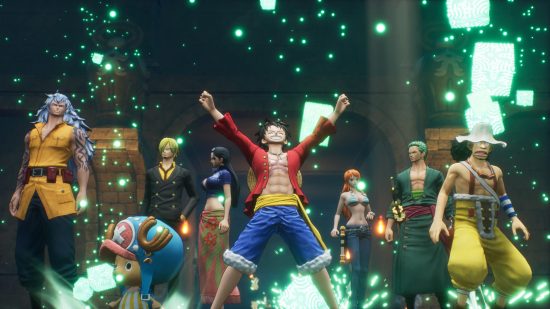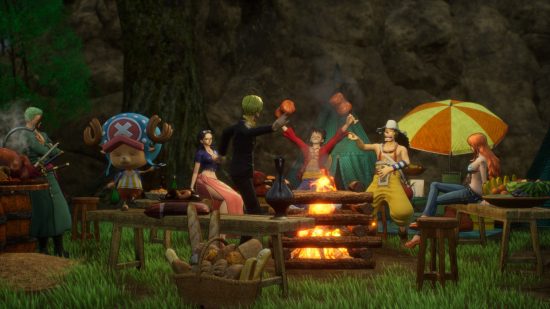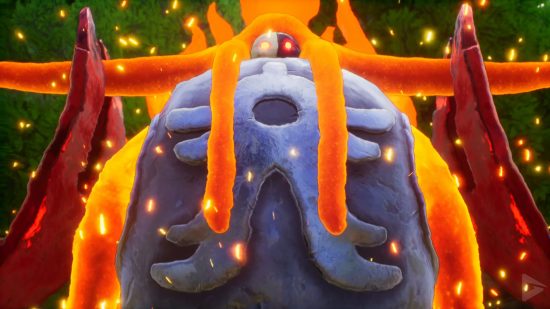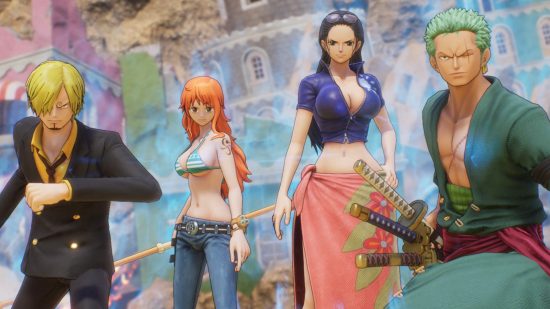Our Verdict
One Piece Odyssey’s attention to detail and respect for its source material informs an original story that is, at times, obfuscated by drab side content, and an innovative combat system that, sadly, rarely gets pushed to its limits.
One Piece is, undoubtedly, one of the greatest stories ever told. 25 years after its initial serialisation, mangaka Eiichiro Oda continues to take the story of Monkey D. Luffy from strength to strength, as the rubbery swashbuckler and his Straw Hat crew continue their journey through the Grand Line.
Conversely, One Piece videogame adaptations have at times lacked lustre. 2019’s World Seeker, for example, looked great until you actually had to play it. In fact, it’s only the Pirate Warriors Musou series which continues to really persist and deliver. As such, there remains a great opportunity for a developer to swoop in and offer a totally different approach outside of the traditional hack’n’slash formula.
Shooting its shot, Pokémon Brilliant Diamond and Shining Pearl developer ILCA has come through with One Piece Odyssey – a bold new vision for the franchise that does away with that tried and true beat-em-up combat, in favour of a turn-based system similar to what you might find in some of the best RPG games like Dragon Quest or Final Fantasy. Not only is the combat fresh but, with the help of Oda-sensei himself, Odyssey also boasts a brand new, original story arc set on the mystical island of Waford.
After being blasted into the sky by a Knock Up Stream, the Thousand Sunny and its crew find themselves marooned on Waford’s South Beach. As the Straw Hats regroup and begin exploring this mysterious new landscape, they quickly run into the Fire Colossus – one of Waford’s guardians. However, before they can defeat the sentinel, their powers are stripped from them by a young girl with a great dislike for pirates called Lim, who has the power to extract memories and store them as cubes.
Fortunately, the crew receives aid from a long-haired man called Adio before it’s crushed by the colossus. In return, Luffy and co. agree to aid him in defeating each of the elemental colossi causing the giant storm that surrounds the island. Simultaneously, the Straw Hats work with Lim to restore their memories, taking them to the world of Memoria over which Lim presides. Here the crew revisits four major locales and events throughout One Piece’s history.
Taking place sometime after the Dressrosa arc – roughly 800 chapters or 750 episodes in depending on your choice of medium – Odyssey has a big ask when it comes to synthesising an experience that can be enjoyed not only by series veterans, but also newcomers – something producer Katsuaki Tsuzuki was particularly keen on achieving.
In attempting to accomplish this, ILCA utilises a dual narrative that not only explores key touch points throughout the series, and offers the Straw Hats a second chance to ‘make good’ on their past despite it not meaning anything, but also delivers a satisfying-enough original story that goes heavy on themes of friendship and found family.
While this makes for a very compelling vehicle to arrive at Tsuzuki’s goal, as an avid enjoyer of the series I would still recommend newcomers dive into the source material after playing, as many of the missing arcs are truly incredible, and remain relevant to the current plot.
Perhaps the greatest joy in the original element of Odyssey’s narrative is Lim’s growth throughout. At first she barely interacts with the Straw Hats, only doing so occasionally with distrust and trepidation. But with time she falls prey to the infectious power of friendship (and some light teasing), and begins showcasing the positive aspects of her personality more and more.
Even if players skip through key cutscenes, ILCA does a cracking job of also baking it into the small pockets of conversation that take place between characters while you’re journeying along. This also helps maintain continuity of the overarching narrative while the crew are exploring the reconstructed islands within Memoria.
This attention to detail can be seen through the various references jotted about Memoria, too. For instance, outside the Spicy Bean in Alabasta you can listen in to a conversation between two NPCs about a hole in the wall being patched up, referencing Luffy, Ace, and Smoker’s run-in inside.
When it comes to gameplay, One Piece Odyssey doesn’t necessarily revolutionise the turn-based JRPG formula, but it does proudly wear its genre influences on its sleeves – sometimes more overtly than others. For example, the crew comes across a chest in the opening dungeon, and Usopp raises his suspicions that it could house something nefarious (Oda-sensei’s take on a Mimic, perhaps). Yet by the time he has finished reeling off his warning Nami has, unsurprisingly, already cracked it open and plundered it.
Indeed, Odyssey does a great job of taking traditional JRPG tropes and making them unmistakably One Piece. This is thanks largely to the sheer amount of love and care ILCA has clearly put into ensuring that the characterisation of each Straw Hat, as well as the chemistry between the group, remains as true to the source material as possible.
Each character has a unique skill that aids in exploring Waford and beyond. Luffy can swing from certain overhanging objects thanks to his Devil Fruit, while Sanji and Nami can sniff out invisible rare ingredients and Berries that are nearby. The PlayStation 5’s Adaptive Triggers bring extra texture here, and offer just enough resistance to make actions like Gum-Gum grabbing items satisfying to the touch.
These idiosyncrasies aren’t just present in the overworld, as each Straw Hat is given their own unique boons and foibles in combat; Luffy is invulnerable to lightning-based attacks, Sanji can’t hit women, and Usopp has the lowest innate Defence out of the crew because, well, it’s Usopp.
Unfortunately, Odyssey’s combat is so easy for the majority of its main story that, for the most part, you won’t have to accommodate for these strengths and weaknesses. The rock, paper, scissors (Power, Technique, Speed) typing ascribed to each Straw Hat and enemy makes understanding when to swap team members around intuitive, though most basic mob fights can simply be cleaved through using the game’s auto-battle feature without much fanfare.
In the forty-plus hours I put into clearing Odyssey, I didn’t have to grind once. This may indicate a smooth progression system, but it’s a bit more complicated than that. You see, I actively avoided mobs like the plague – or Caesar Clown’s gas – and yet I never once felt that I was under-levelled. This could be due to the game’s Dramatic Scenes system which, in return for completing an objective randomly generated in combat every now and then, would slap on a meaty multiplier to the encounter EXP. In fact, I would often get more One Piece Odyssey EXP from a random mob than actual boss encounters in the same area which is… not right.
When it comes to facing one of said One Piece Odyssey bosses, things can get hairy very quickly, and it’s here that the combat system really shines. When squaring off, you not only have to think about type matchups, but what sorts of consumables you should be using to buff your team and debuff your enemy, as well as where each member is positioned within Odyssey’s excellent Scramble Area Battle layout, lest you wish to take a hard L.
‘Scramble Area what now?’ you say. Well, one tweak to the JRPG formula Odyssey does make is how the One Piece Odyssey characters are deployed across the field. Each encounter will split the Straw Hats and their adversaries into zones, necessitating the use of certain moves, defeating enemies, or making use of the party switcher to shift them into more favourable positions.
This is really quite clever, as it allows the developer to better separate the use cases of, say, Luffy’s Gum-Gum Pistol from his Gum-Gum Bazooka – the latter of which can actually send a single target flying into a different zone, ready to be blasted by an AoE attack along with anyone else unfortunate enough to be in the vicinity. Additionally, this bolsters the power of certain characters at points in the story – for a long time Nami is the only Straw Hat who has an ability that can hit the entire field, for example.
The abilities themselves are beautifully animated, which is very much a necessity when you’re looking at them over and over again throughout Odyssey’s hour runtime. The weight of each move – be it Robin’s nut-cracking Dos Fleurs Grab, or Luffy’s earth-shattering Gum-Gum King Kong Gun – feels spot on, and if you do want to move things along a little there is an in-combat Speed Up feature which shifts everything into double-time. I definitely spent the greater part of my playthrough with this setting on.
It’s not just the abilities that look great either. The Straw Hats, alongside the various NPCs and beasties – many of which were designed by Oda-sensei himself – that inhabit Odyssey’s world are moulded from a blend of traditional hand drawn and more modern CG styles. The result is a fully 3D experience that doesn’t look out of place when compared to the source material – yet another example of ILCA’s careful craft.
This translates into Odyssey’s geography, too. Between the island of Waford and the Memoria recreations of those four iconic locales, nothing looks out of place. Cities and their surrounding areas are detailed, and bustling with plenty of NPCs that all offer up unique tidbits of information or lore. The creative team has clearly enjoyed the flexibility afforded by the fallibility of the Straw Hats’ memories, with new visual flavours tastefully added to each location that weren’t present in the original series.
Unfortunately, not all is sunny within Memoria’s materialisations. Odyssey’s actual side content is serviceable at best, and miserable filibustering at worst. I spent an inordinate amount of time in Alabasta – the biggest culprit of the latter – running back and forth between areas to complete largely-unrewarding side quests (kill X monsters, collect Y items, the usual filler). The result is an unnecessarily inflated run time in the region, causing Odyssey’s overall pacing to become lopsided.
To give the tertiary content some credit, Odyssey’s bounties are fun, introducing a myriad of oftentimes goofy characters that at least make up for the poor rewards you get from them. Furthermore, there are some great moments within the One Piece Odyssey Memory Link locations, which have the Straw Hats piece together Frayed Memories within Memoria’s mirror world – Hysteria.
On the performance front, frame rates remained consistent as I ran through the vast deserts surrounding Anohana and Alubarna for what felt like the hundredth time. The PS5’s Performance Mode was the go-to for my playthrough, and I only noted one noticeable drop in frames which came during a particularly intense cutscene towards the backend of the game.
The final facet of Odyssey to touch on is its audio. Those long slogs in Alabasta were further aided by Odyssey’s exceptional score, with Motoi Sakuraba (Dark Souls series, Tales series) utilising his compositional prowess to produce a soundtrack that, quite simply, bangs. There’s also the voice acting, which is about as excellent as you can expect from the anime’s original cast – Masaya Matsukaze (Adio) and Marika Kono (Lim) also put in top tier performances.
One Piece Odyssey is an impressive love letter to a series which continues to delight and innovate a quarter of a century after it first hit the shelves. While the Straw Hats’ adventure in Waford isn’t quite up there with the very best One Piece arcs, Adio and Lim are welcome additions to Oda-sensei’s non-canonical world. Despite exquisite attention to detail across the board and an innovative combat system, Odyssey’s balance is off-kilter at times. As such, while Odyssey could very well make a case for being the best One Piece game yet, there is still plenty of room for improvement.



